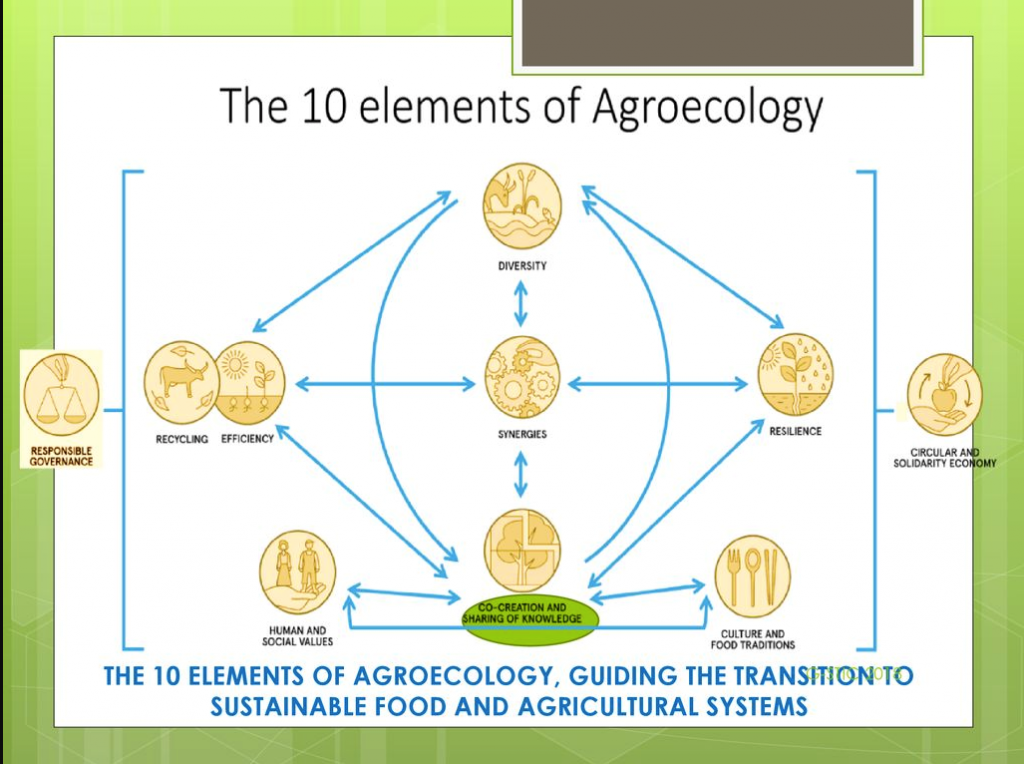The 10 Elements Of AgroEcology – Guiding The Transition To Sustainable Food And Agricultural System
-Shreya Gangwar
According to Global Hunger Index 2020, 690 million people are undernourished, 144 million children suffer chronic malnutrition and 5.3 million children died before their fifth birthdays in 2018 and a million children suffer from wasting. Current crisis COVID-19, LOCUSTS attacks have increased food insecurity creating localized spikes in food prices, and reducing income-earning opportunities, thereby limiting the ability of vulnerable populations to purchase food and ecological condition are the reason for it. Now let see how this ecological condition will transit to sustainable food and agricultural systems and help in crops growth and motivating the farmers and displace malnourished with FAO principle on – “The 10 Elements of Agroecology” achieve Zero Hunger by 2030.
 Agro-Ecology is an integrated approach that applies ecological and social concepts to style management of food and agriculture systems. It supported co-creation of data (practical or local), combining science with the normal by enhancing adaptive capacity to empower producers and communities with how to supply holistic and contextualized solutions to local problems. Hence developing an agro ecological with 10 elements will help to realize Zero Hunger. These elements are supported by foundational practices and innovation, feature surroundings and enabling environment.
Agro-Ecology is an integrated approach that applies ecological and social concepts to style management of food and agriculture systems. It supported co-creation of data (practical or local), combining science with the normal by enhancing adaptive capacity to empower producers and communities with how to supply holistic and contextualized solutions to local problems. Hence developing an agro ecological with 10 elements will help to realize Zero Hunger. These elements are supported by foundational practices and innovation, feature surroundings and enabling environment.
DIVERSITY
Agro ecological systems are diverse. It optimizes the diversity of species or genetic resources through agro forestry systems increases vertical diversity, intercropping increases spatial diversity, crop rotation increases temporal diversity. Also, crop-livestock systems increase the diversity of local breeds, fish polyculture farming, integrated multi-trophic aquaculture etc. Increasing diversity strengthens ecology and socio-economic resilience creating new market opportunities.
CO-CREATION AND SHARING OF KNOWLEDGE
Co-creation process blends traditional and indigenous knowledge, producers-traders practical knowledge and global scientific knowledge. Both formal and informal education shares agro ecological innovations resulting from co-creations.
SYNERGIES
It means working together. Agro ecology pays careful attention to design a diversified system that combines crops, livestock, aquatic animals, trees, soils etc. to enhance synergy in the context of changing climate. By optimizing biological synergy and enhance ecological function at its utmost efficiency, improve yields, dietary diversity, weed control, soil structure, fertility etc.
EFFICIENCY
It means producing more using fewer resources. It is to improve the use of natural, abundant and free resources such as solar energy, atmospheric carbon and nitrogen. It promotes less usage of external resources by reducing dependency and empowering producers by increasing their autonomy and resilience.
RECYCLING
Agro ecological practices support biological processes that recycle nutrients, biomass and water and thus increasing efficiency and reducing wastage and pollution. It can be done through various systems like agro forestry systems, crop-livestock systems, rice-fish systems etc.


RESILIENCE
Agro ecology approaches to enhance socio-economic resilience through diversification and integration, reducing commodity fail and dependence on external inputs. Diversified Agro ecological system has a greater capacity to recover from disturbances, biological complexities and developing community to self-regulate pest outbreaks.
HUMAN AND SOCIAL VALUES
Agro ecology holds a paradigm that empowers people to become their agents. Agroecology and sustainable development goals place a strong emphasis on human and social values. It depends on a different way of agri-production that is knowledge-intensive, effective-efficient, innovative, climate-friendly and labor-intensive with rural youth pisses energy, creativity and desire to change their world.
CULTURE AND FOOD TRADITIONS
Agro-ecology seeks to cultivate a healthy relationship between people and food so focusing only on increasing production is not sufficient; culture and food traditions play a vital role in society. Cultural identity, indigenous- traditional practices and sense of place evolve together in the ecosystem that can bring ways to promote healthy food production and consumption.
RESPONSIBLE GOVERNANCE
It is the call for sustainable food and agriculture from local to a global level. The accountable government mechanisms and legislation, policies, programs to support producers and regulate the market to secure access to proper aquatic and territorial resources.
CIRCULAR AND SOLIDARITY ECONOMY
It seeks to connect producers and consumers to provide innovative solutions that prioritize, supports and creates local markets needs, resources, capacities and economic development by creating a virtuous cycle. Strengthening food circuits can increase incomes of producers and maintain fair prices for consumers and link consumers and producers in schemes. with the help of a circular economy.
The practice of observing ecological phenomena within the agro-ecosystem and optimizing these phenomena for human benefits has many names and has been happening since the dawn of history. Agro ecology is not the same as bio-dynamics, organic farming or permaculture; However, it is a science, whereas these are practices that originated from observing food chains in nature. Hence empowering Agroecology seems to be the need of the hour looking at the current situations and achieving the goal of ZERO HUNGER.